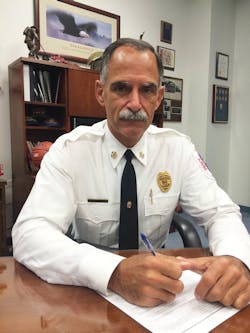As we grow, we learn that many things are identified differently depending on your location or what society you are associating yourself with. Weight is represented by different measurements (pounds vs. kilos), temperature by different degrees (Fahrenheit vs. Celsius), and the spoken word is spread over a vast diversity of languages and dialects.
I submit to you that while many things in life are measured or articulated in ways that seem foreign to us, there are some things that manifest fairly universally. Two that stand out to me are time and outcomes. No matter what department you work for, what state you’re in or what continent you’re on, the events of similar circumstances, within a given time, will have similar outcomes.
How many times have you been at a scene or watched a scene video and said “if they don’t do something soon, then something bad is going to happen”? Do you know someone who’s been injured because they weren’t wearing proper PPE or they weren’t wearing their PPE correctly? Do you know anyone who’s ever been injured not wearing a seatbelt or involved in a drunk driving accident?
In life—just as in the fire/EMS department—we learn, we educate, we train, we adapt, we legislate, and we train some more—yet somebody usually ends up standing at the same spot, invariably saying, “How could this possibly happen?” Occasionally bad things are unavoidable; however, bad outcomes are usually completely predictable and preventable.
Avoidable vs. unavoidable outcomes
The “avoidable” outcomes are the ones we’ll focus on for this article. Typically, our main challenge in recognizing avoidable outcomes comes down to somebody/everybody “following the rules” while avoiding the tendency to become a “robot” (Firehouse Magazine, September 2015, Chief Concerns column “Thinkers vs. Robots”). It is critical to be a “thinker” so when the “unavoidable” things do happen, you are able to adapt and overcome more quickly, which will help you avoid worse outcomes.
General orders or standard operating procedures (we’re not even going to get into the debate over naming: order/procedure/guideline) are generally designed or developed to provide the basis for predictability. In many cases, you can pin a name or an incident to particular orders or SOPs, specifically where people were hurt or apparatus was damaged because someone did something “wrong.”
If we don’t deploy our hoods properly, we get facial burns—predictable! We wear wet gear into a fire, we get steam burns—predictable! We fail to lay a supply line, we run out of water—predictable! We don’t use barrier protection on a patient, we contract communicable disease—predictable! We don’t place used needles into a sharps dispenser, we get a needle prick—predictable! We don’t control an intersection, we get broadsided by a car—predictable! We don’t use larger equipment for highway barrier protection, we get struck on scene—predictable! We don’t take care of ourselves physically, we suffer a cardiac event—usually predictable! We don’t use our SCBA warning devices to balance our time to get out, we experience a mayday or even death—predictable! You get the picture?
Most of the orders and SOPs are developed to provide efficiency and to protect people and property. Sometimes, those pesky orders get in the way of being able to do things the way you want to do them—as I have said in other articles, GET OVER IT!
Make a difference
So how do we make the predictable, avoidable? We said before that we learn, we educate, we train, we adapt, we legislate, and we train some more, so what are we doing wrong? I’d submit that a significant amount of making the predictable, avoidable lies within the being of each of our personal, organizational and administrative disciplines.
Personal responsibility
Each of us have to be personally disciplined to become that “Attention-to-Detail Guy” (Firehouse Magazine, Chief Concerns column, October 2015). If we don’t take the details seriously, how do you expect the younger folks to understand the difference? We must respect the rules, the public trust bestowed upon us, the requirement to place ourselves in harm’s way, and the need to recognize when “enough is enough” (Firehouse Magazine, Chief Concerns column, January 2016).
Organizational responsibility
There will always be buzzards who pick apart the chief’s decision to do X or Y; however, a professionally thought-out and standardized approach to most problems will provide the basis of learning that makes the predictable, avoidable. Simply identifying those approaches is not enough. One of the most frustrating things I hear from folks is that the “department knew about this problem and did nothing about it!” Keep in mind, this particular discussion has nothing to do with the minutia of union or volunteer issues. We’re talking about systemic concerns that address predictable physical outcomes involving our folks.
The PGFD undertook an exercise in “Organizational Responsibility” after a 2012 near miss. The results of that exercise were astounding—albeit predictable and unfortunately not unique to many of my fire service cohorts experiences.
Picture two young truckie firefighters ready to enter the first floor-front door of a 900-square-foot, single-family home, with a basement fire blazing below. No one else has yet entered the home. The engine crew was literally “right behind” them. The department had not yet embraced flow-path science, specifically as it relates to attacking basement fires. The fire was venting through a Bravo basement-level window, around the corner from a large still-in-tact sliding glass door entrance. There’s 40 mph winds blowing directly against the Charlie side wall. Except for the venting window on Bravo side at the basement level, the house is closed-up tight. There’s a vehicle in the driveway and toys scattered around.
Our truckies give a thumbs up to the engine crew and bust through the front door (creating a flow path). The high-pressure trying to exit the basement (aided by the 40 mph winds) suddenly finds a low pressure path out the front door. The two guys make it in, the door slams shut behind them—nobody else and no hoseline in the door. The room temperature instantaneously rushes to nearly 1,000 degrees before the flow path is cut off by the now-closed door. The environment is nearly unsurviveable, and the firefighters hug the floor behind the door. One firefighter struggles out of a front window, while the other lay motionless below. Screams, shouts, horror for at least a minute as that firefighter and others now struggle to push open the blocked door and drag the apparently lifeless firefighter out of the front door. Seven firefighters would find themselves in the hospital before this debacle was over. Two of the firefighters were in serious condition, one of those critical. The others were treated and released. Since this incident, everybody’s physical scars have healed and most have returned to full service.
Fast forward to completion of a 14-month Safety Investigation Team (SIT) report, complete with 46 recommendations for change and improvement in the PGFD. I asked staff to conduct an analysis of other SIT report recommendations, as they may relate to this current report. Twenty of the current report’s 46 recommendations remained essentially unresolved, as had been noted in as many as seven other SIT reports over the course of 20 years. In a future article, we will share the recommendations and courses of action taken toward implementation of those recommendations.
Administrative responsibility
Ultimately, there has to be administrative accountability along the way. Public safety folks should be held to a higher standard than the “average Joe.” Our actions (or inactions) and our decisions in the course of normal duty may have life and death consequences. There must be a system in place to administratively discipline those individuals or systems who consistently and continuously fail to comply with or enforce “the rules.” Specific discipline has to be part of your organizational culture—not just a slap of a wrist after-thought that disappears as quickly as it happens. Discipline and administration is challenging; however, it is not akin to “rocket-science.” We are talking about pure and unadulterated LEADERSHIP.
Summary
If we’re ultimately going to make the predictable, avoidable, it is imperative that no other fire chief has to spread this kind of absolutely unacceptable news to anyone. The PGFD continues to work to resolve the 46 recommendations mentioned above. More than half of the recommendations are fully implemented, with the remainder in various states of exploration and/or implementation. Funding and systemic culture change have been the most difficult obstacles to overcome during this process—both situational road blocks that are also very predictable.
Do the right things, for the right reasons, at the right times. Don’t allow your actions, or in-actions, to become the reason for the next order or SOP. Don’t allow yourself or your department to become the next predictable statistic.
About the Author

Marc S. Bashoor
MARC S. BASHOOR joined the fire service in 1981. In 2017, he retired as fire chief of Prince George’s County, MD, Fire/EMS, the largest combination department in North America. His progressive community-based approach led to record hiring and a strategic apparatus replacement plan.
Twitter: @ChiefBashoor
Email: [email protected]
